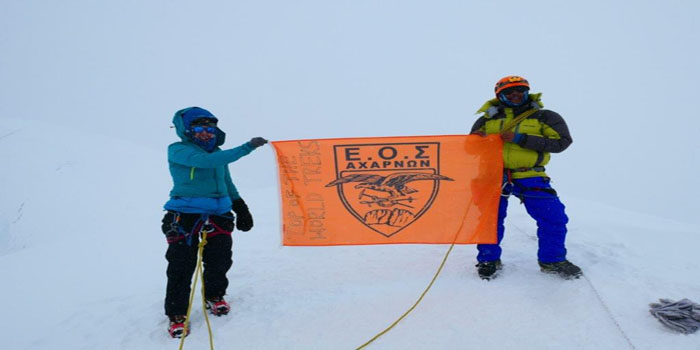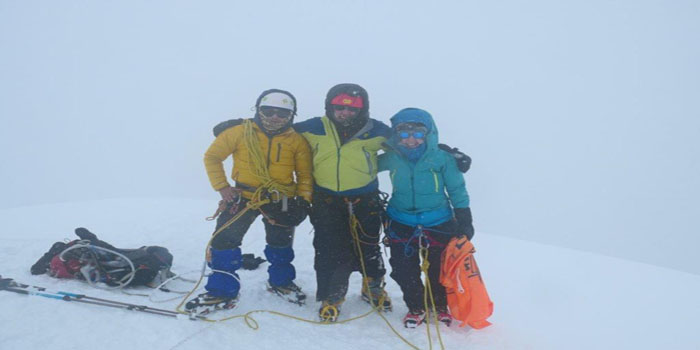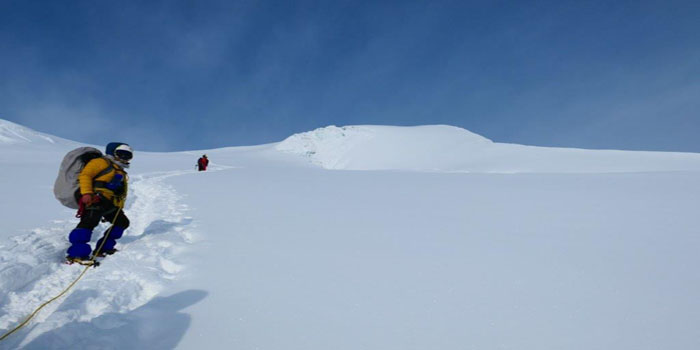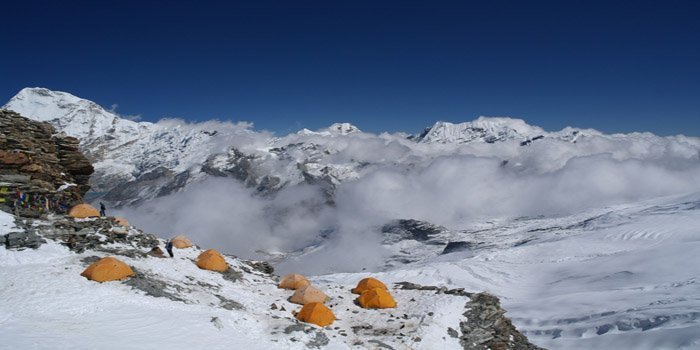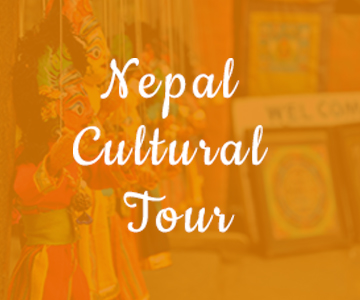Trip Introduction
Mera peak is located in the east of Khumbu trekking trail of Everest region. This peak has a consuming fascination for some who wish to climb a major peak in the Khumbu region. Likewise, Mera Peak Climbing is somewhat challenging and will be the exhilarating experience. Though the climbing here does not require very technical knowledge you should have some experience and skills concerning climbing instruments such as ice axe rope and crampons.
We start in Lukla and as we follow the path it crosses high ridges and deep gorges in Everest region the native soil of legendary climbers ‘Sherpas’ before entering to the isolated wilderness of Hinku Valley. Besides that, Annually 700 foreigners make an attempt to climb Mera peak which demands preliminary mountaineering experience and a special permit from Nepal Mountaineering Association. J.O.M Roberts, Sir Edmund Hillary and Tenzing Norgay were the first masters who got victory over Mera peak on 20 May 1953.
Before we start our climb to Mera peak we organize a basic climbing course. So that all of our climbers have basic and advance climbing knowledge. In this way, they get confidence to get triumph over the summit. In the weather condition is good we can climb the peak and descend back on the same day. From the pinnacle of Mera peak we can have the outstanding view of Mt Everest,(8848m), Mt Lhotse,(8516m) Mt Makalu,(8463m and Mt Cho Oyu(8201). Mera peak climbing is a three nights tented camping trek. Our kitchen staffs are a trainable and good experience where they will serve you fresh, hygienic and tasty food.
What's included
-
Four nights accommodation in a three star Hotel in Kathmandu including breakfast. This will be for the two nights before trek and two nights after trek.
-
All accommodation whilst on trek.
-
You are able to choose any food, any tea and coffee from menu for breakfast, lunch and dinner.
-
ekking permits, National Park fees and Peak Climbing Permit if needed.
-
Internal Flight for Members, Guige and Assistant Guide
-
Kathmandu –Lukla and Lukla - Kathmandu Round flight ticket
-
All domestic airport taxes.
-
Peak climbing Guide and Trekking guide equipment and salary
-
One Assistance Guide who support to pitch tents and guarding camp at night / as per group size.
-
One Cook and One kitchen supporter/s as per group size.
-
Required kitchen utensils
-
Cooking fuel and lighting service
-
Required portage service to carry tents, food stuffs, fuels & kitchen utensils Necessary tent and equipment
-
All the staff insurance, well paid salary, equipment, transportation.
-
All the transporting.
-
Government taxes and service charge.
-
Medical supplies (first aid kit
What's excluded
-
Nepal visa.
-
International airfare.
-
Travel and rescue Insurance
-
Hire of climbing equipment if not bringing own.
-
Food in Kathmandu and Pokhara
-
Extra night hotel accommodation in Kathmandu if arrive early or late departure.
-
All the hotel accommodation or meals in Kathmandu.( in the case return early from trek due to any reason)
-
Personal expenses( bar bills, coke, beer, bottle of water, phone call, laundry service etc.
-
Tips for guide porter.
-
Day 1
Arrival in Kathmandu
Welcome to the country of Top of The World! As you arrive in Tribhuvan International Airport, our representatives will receive you and transfer to the hotel and check into the hotel there is time for a cup of tea, shower and then a chance to see the tourist district of Kathmandu by night as we go for dinner before an early night!
-
Day 2
Sighteeing in Kathmandu
A day in Kathmandu where we will take you to Swayambhunath which is a Buddhist stupa and Monastery, which is over 2000 years old and one of the oldest in the world. Here is a great chance to see across the valleys, see some monkeys and begin to learn about this fascinating country.The afternoon will be spent getting for the trek and some time to relax and make sure all the kit and packing is complete. Also the first time you can go shopping which inThamel is an adventure in itself!
-
Day 3
Trek to Chutanga (3,430m).
Our first day of trekking is quite easy which takes us to eastwards. Passing through number of villages and dense forests we come across Nau Lekh also known as Kalo Himal Ridge. On this portion we will closely follow our guide as there are number of paths leading away from the main trail. The whole area is known as Chutanga which literally means summer pasture. Overnight at tented camp.
-
Day 4
Acclimatisation Day at Chutanga
Acclimatisation day. We make a trek up to around 4000 metres giving views over the Dudh Khosi Valley and across to the Zatwra La pass. After a liesurely lunch taken at this high altitude, we return to Chutanga for a good night's sleep. Camp.
-
Day 5
Today we will trek for around five to six hours from Chutanga to reach Tuli Kharka
We begin our walk with the steep climbing to cross Kalo Himal Ridge in Nau Lekh Range which separates Khumbu valley from Hinku Valley. Further uphill climbing will bring us to the small pass called Zatrwa Og(4450m), from here the path transeverses a boulder slope, rounds a corner and climbs once again to the Zartwa La at an altitude of 4600m. in fine weather the one can witness the outstanding vista across the Dudh Koshi towards Karyolung and Lumding Himal and in foothills of Hinku Valley. From here we will climb downhill for less than hour that will bring us to large boulder at Tuli Kharka where we will spend overnight.
-
Day 6
Trek to Mausan Kharka (3430m). Trek for about 3 to 4 hours
We have a short trek on a downhill slope where we can see the terrific vista of Peak 43 and Kusum Kanguru before we reach to Hinku valley from where we can see the majestic view of South face of Mera Peak. Continuing the walk we drop steeply into the Hinku valley. A pleasant and fine walk through the Himalayan Pine and Rhododendron forest take us to Mausam Kharka by Hinku Drangka River and overnight at tented camp.
-
Day 7
From Mausan Kharka trek toThagnan(4360m)
We walk along the west bank of Hinku Drangka eventually leaving the forests. We cross the small bridge to reach Gondishung(4350m) which is the summer settlement of Thagnag. Gondishung has a enthralling 200 year old monastery beneath a rock overhang. The trek continues for another hour passing Lungasamba as the valley narrows between the flanks of Kusum Kanguru(6369m) to the west and shortened far western peak of Mera(6255m). Finally we reach at Thagnag which is a small settlements made by Yak herders. Here we find few tea house cartering the needs of travelers and porters.
-
Day 8
Acclimatisation Day at Thgnan
Today we acclimatize at Thagnan and explore the area. We too can do some local hikes in these stunning peaks especially Peak 43 which rises to 6769. In the north of the camp there is moraine behind where is beautiful glacial lake known as Sabai Tsho into which plummets the hanging Sabai Glacier.
-
Day 9
Trek to Khare(5000m) which takes 4 to 5 hours via Charpatti Tal, Dig Kharka.
-
Day 10
Trek to Mera Base Camp (5,300m) which takes 4 hrs.
The path is zigzag which bring us to the Mera Glacier. From here we must use crampons for 15 minutes to climb the 30 to 35 degree ice to reach the plateau that leads us to Mera La (5,415m). Normally, the pass will be covered with snow from Nov.- April. Again the views from the pass are spectacular. We descend about 100m towards the Hongu side and set up the base camp (5,300m) in the moraine below the ice. We embrace the spectacular scenery of snow-slope and the panorama of Himalayan peaks.
-
Day 11
Trek to Mera High Camo(5800m) which takes 3 hrs.
we continue our trek for another 3 hours which take us to High Camp beneath Mera Peak. From here one can see the spectacular vista of Makalu, Everest, Nuptse. If the weather is fair from High Camp we will have the panorama of Kanchanjunga in the far east. Overnight camping at High Camp.
-
Day 12
Summit and Down to Khare.
Early in the morning after having breakfast we will conquer the summit of Mera(6476m) . Though the distance does not look far the climb requires much of a hard work and all the preparation and positive attitude will pay off here. It takes 4 to 6 hours for summit. For the summit we start to trek from 2 am to 5 am in the morning. As the sun rises we can see the incredible vista across to Baruntse(7129m) , Nau Lekh(6360m) and Makalu(8481m). After conquering the summit we climb down to Khare. The exact schedule depends on many factors including the weather, condition of the route and condition of the members.
-
Day 13
Spare day if incase weather condition problem.
There is no guarantee that we will have favorable weather on our planned day for the summit (day 12). Therefore, this day is set aside as a contingency in case we are unable to summit the Mera on day 12 due to bad weather conditions or any other unanticipated reason. However, if the trip goes smoothly, we do not need this spare day, we can use this day to walk back to Lukla at a leisurely pace.
-
Day 14
Khare to Kothe
After a successful expedition on Mera Peak we climb down through Hinku valley to Gothey(3600m). On the way we can see the panoramic vista of Himalayan valley and majestic mountains. Overnight at Kothey in the camp.
-
Day 15
Trek to Tuli Kharka(4250m).
Early in the morning after having breakfast we clim uphill through the lush forest on the west side of Hinki to the Valley of Tuli Kharka. Overnight at camping.
-
Day 16
Trek to Lukla(4600m).
After having breakfast we climb uphill to the top of Zatrwa La and climb downhill to the village of Lukla. Overnight at teahouse in Lukla.
-
Day 17
Lukla to Kathmandu
An early start to the airport and weather permitting a flight back to Kathmandu. We will arrive back to hotel mid morning and a welcome shower and clean clothes will be waiting for you. The rest of the day will be at your leisure with lunch, shopping in the Thamel and adjusting to civilisation!
-
Day 18
Kathmandu Sighteeing
Today after a leisurely start we will continue the tour of Kathmandu by visiting the largest Buddhist stupa in the world. Boudhanath stupa is a world heritage site and a place which is an amazing place to see Buddhism and understand more about not only the religion but the Nepali culture. A group dinner will be had in the evening to celebrate the end of the trek.
-
Day 19
Departure Day
Return to theHome . Extra days are available at your own cost but we will be happy to arrange this for you.
FLIGHT
For all the Everest Treks you will be flying from Kathmandu to Lukla and then at the end of the trek, you will need to do the return flight. This flight is very weather dependent and can be delayed or cancelled at short notice if the weather is not suitable for this mountain flight. At Top of the World Treks, we will do our best to manage this situation and if your flight is cancelled we will do all we can to get you on the next available flight. It maybe is possible for a helicopter to be charted but this will be at an extra cost and up to the group at the time. We plan extra days into our itineraries in case this happens but you are also welcome to plan extra days if you wish.
We can arrange sightseeing and tours in Kathmandu if you wish on these extra days. If the weather continues to see cancellation then it must be decided on the group whether to continue to wait or transfer the trek to another range – such as Annapurna or Langtang. We will fully advise you if this becomes the case.
IMPORTANT NOTE
Please be aware that your safety while in Nepal is our number one propriety. All itineraries are subject to change if there are safety concerns, health concerns of people in the group and/or weather concerns. This will be decided by the trek leader but we will always discuss the options with the group where possible to ensure peoples wishes are taken into account, however, the Treks leader decision is final.
Book our fixed departures
Equipments
Equipment Check – List
What clothing and equipment to take is one of the things that people worry the most about! We can advise you and help you and it does, of course, depend on the time of year, the area, the altitude and how many days you are trekking/climbing. When you arrive in Kathmandu we will go through all your equipment to ensure that it is correct for your trip. In Thamel (the tourist area of Kathmandu where you will be staying) there is an abundance of shops selling equipment and clothing so if anything is forgotten it can easily be sourced. It is also possible to hire climbing equipment and also items such as down jackets, and sleeping bags saving you a large purchase.
The following equipment list is suggested and necessary for both camping and tea house treks. Use this list as a guideline. The basic checklist should help you with your packing for any of our trips. Please remember that you should always try to keep the weight of your clothing equipment down to a minimum. Your packed trek bag should weigh no more than 15kg. Please remember this is just a checklist and you do not necessarily need to bring everything that is listed below.
GENERAL CHECKLIST
The following basic checklist should help you with your packing for any of our trips. Please remember that you should always try to keep the weight of your clothing equipment down to a minimum. Your packed trek bag should weigh no more than 15 kilograms. Please remember this is just a checklist and you do not necessarily need to bring everything that is listed below. Use your own experience and judgment to make your decision.
-Light and expedition weight thermal tops.
-Fleece jacket or pullover.
-fleece wind –stopper Jacket (optional)
-Waterproof shell jacket (preferably breathable fabric)
-Lightweight thermal gloves.
-Underwear (4)
-Shorts (2)
-Lightweight cotton long trousers/pants.
-Light and expedition weight thermal bottoms.
-Sun hat or Scarf.
-Warm fleece hat or light balaclava.
-T-shirt (2)
-Thin, lightweight (inner socks) (4).
-Sunglasses with UV protection.
-Sleeping bag rated to 0 degrees ¾ season
-Headlamp (eg Petzl) Spare bulbs and batteries.
-Small padlock to lock trek bag.
-Basic first aid kit(see First aid medicine bellow)
-Plastic bags –for keeping items dry inside trek bag.
-Daypack ( 35 to 40 litters/ 2500 to 3000 cubic inches.)
-Camping mattress, eg Thermarest pad.
-water bottles.
-Toiletries.
-Small wash towel.
-Footwear, appropriate to the trip.
-Waterproof shell trousers/pants. (Preferably breathable fabric)
TREKKING CHECKLIST
In addition to the items listed in our general checklist you will need to take the following on your trekking trip:
-Heavyweight gloves or mittens with a waterproof shell outer.
-Down vest and/ or jacket (optional).
-Fleece or wool trousers/ pants.
-Trekking/ hiking boots with spare laces.
-Thick, warm wool hiking socks (4)
– Footwear for around camp, eg running shoes and /or sandals.
-Gaiters (optional).
-Telescopic trekking/ ski poles (optional)
MOUNTAINEERING / CLIMBING CHECKLIST
In addition to the checklists for general trekking equipment above, and depending on the trip you have chosen, various items of mountaineering equipment may also be required, eg:
-Plastic boots and crampons (preferably step – in bindings ) with front points.
-Mountaineering Safety harness.
-Mountaineering Ice axe(60 to 75 cms long – depending on your height and personal preference).
-120 cms (4ft) climbing sling and to locking and unlocking caravans.
-Telescopic ski – sticks (optional).
-Prussik loops.
-Climbing helmet (optional).
-Jumper (Ascender & Descender).
-Pocket Knife.
-Headlamp.
-Mattress.
-Rope and Snow bars.
-Ice crew.
-High altimeter.
Most if not all of this equipment will be needed for any trip that crosses steep, snow-covered ground, or which includes sections of glacier travel. Our recommendation that you take no more than fifteen kilos of trekking equipment dose not include your plastic boots, ice axe, Crampons otherness/carabiners. During the trek, climbing hard wear will be carried separately from your trek bag, in group bags until needed.
EQUIPMENT RENTAL
To minimize your expense outlay for trekking and climbing equipment you may never use again, equipment rental and buying is possible in Kathmandu. You find them a lot cheaper than you find in Europe and the USA. Shops in Thamel offer a wide range of equipment available for rent and buy. Here is some cost which gives you an idea of the cost to rent in Kathmandu.
-Sleeping bags.
-Down Jackets.
-All-purpose mountaineering Ice axe (60 – 70 cms)
-Ice hummer.
-Climbing Harness.
-2 looking Carabiners, Climbing Sling.
-12 – point Crampons.
-Plastic Climbing boots.
-Helmet.
FIRST AID MEDICINE
-Bandage for Sprains.
-Plaster/ Band-aids.
-Iodine or Water filter(optional)
-Moleskin/ Second skin – for blisters.
-Antiseptic ointment for cuts.
-Anti-bacterial throat lozenges (with antiseptic)
-Aspirin/ paracetamol- general painkiller.
-Oral rehydration salts.
-Broad-spectrum antibiotic (norfloxacin or ciprofloxacin).
-Anti – diarrhoea medication (antibiotic).
-Diarrhoea stopper (Imodium – optional).
-Antibiotic for Giardia or similar microbe or bacteria.
-Diamox (Altitude sickness – can be bought in Kathmandu.
-Sterile Syringe set (anti-AIDS precaution).
– For more details please see our staying healthy topic.

